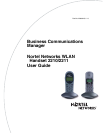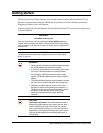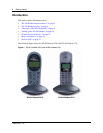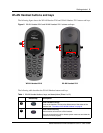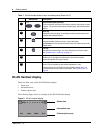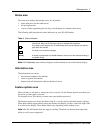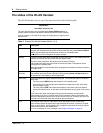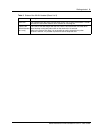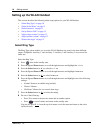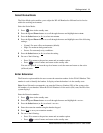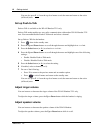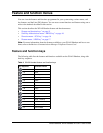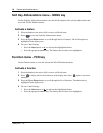
8 Getting started
N0009103 1.0
The states of the WLAN Handset
The WLAN Handset can be in one of the states described in the following table.
IMPORTANT!
User MUST end every call
The user must end every call, by pressing the Power Off/End Call key, to
release system resources and allow the WLAN Handset to function properly.
If this is not done, it will result in the ringer not ringing and you might miss an
important call.
Table 3 States of the WLAN Handset (Sheet 1 of 2)
State Description
Power off The handset is turned off. It is not registered with the Call Server.
Normally the handset enters the power-off state when the user presses Power Off/End
Call
for approximately two seconds when the set is in the standby state.
The batteries can be recharged in the power-off state.
Standby This is the normal state when the handset is online but inactive. In the standby state, the
handset can receive calls and access the User Option menu.
To perform other operations, the handset must be active (off-hook).
The standby state uses less power than the active (idle) state. The batteries can be
recharged in the standby state.
When the handset is in the standby state, the programmed extension number is shown in
the display area.
Active
(off-hook)
This is equivalent to a regular telephone being off-hook.
The handset goes to the active (off-hook) state by pressing Power On/Start Call when
the handset is in the standby or active (idle) states.
Active (idle) This is equivalent to a regular telephone being idle. The active (idle) state is reached in
three ways:
• The user presses MENU when the handset is in the standby state.
• An incoming call in the Standby state causes the handset to go to the active (idle)
state and begin ringing.
• The user presses FCN and 3 when the handset is in the active (off-hook) state to
access the function menu. In this state, the handset does not ring when a call comes
in.
In the active (idle) state, the handset and access point exchange a small packet
approximately once every 15 milliseconds. This increases the power consumption and
consumes bandwidth, particularly for the RF portion of the link. Therefore, the set is not
normally left in the active (idle) state except for special situations.
Error The handset enters the error state when it loses the signal from the access point.
If the handset regains the signal within approximately 20 seconds, it returns to its state
when it lost the signal. If the handset is out of range for longer than 20 seconds, the set
restarts and returns to the standby state.
For more information on error messages, see “Display messages” on page 27.



